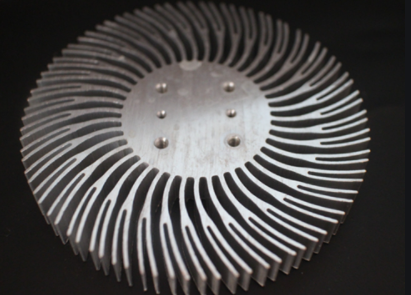When the packaging technology is still in its infancy, the lamp system design becomes even more critical. Lamp producers must now concentrate their efforts on figuring out how to maximize chip life and light quality. “Heat” is the primary influencer of the above. Each chip has a node temperature, which should be regulated within 85 ° C to provide the optimal operating condition of the device. How can we make sure that heat from the chip, aluminum substrate, heat conducting material, and the radiator can be transported easily and effectively to the surrounding environment?

In addition to the meticulous design of the construction of each link by the engineer, the material selection and process treatment of each link should be thoroughly examined and tested to reach the optimal functioning condition. How can we make sure that heat from the chip, aluminum substrate, heat conducting material, and the radiator can be transported easily and effectively to the surrounding environment. In addition to the meticulous design of the construction of each link by the engineer, the material selection and process treatment of each link should be thoroughly examined and tested to reach the optimal functioning condition.
Characteristics of aluminum profile:
Resistance to corrosive substances
The density of aluminum profile is just 2.7g/cm3, roughly 1 / 3 of that of steel, copper or brass (7.83g/cm3 and 8.93g/cm3 respectively). Even in corrosive environments like seawater (or brine), petrochemicals, or air, aluminum holds up admirably well against oxidation.
The ability to conduct electricity
The high conductivity of aluminum profile makes it a popular material for use in aluminum framing. On the basis of comparable weight, the conductivity of aluminum is roughly double that of copper.
Conductivity of heat
It is possible to make heat exchangers, evaporators, heating appliances, cooking utensils, and vehicle cylinder heads and radiators using aluminum alloy since its thermal conductivity is around 50%-60% lower than copper’s.
Incompatibility with ferromagnetic materials
Aluminum profile is non-ferromagnetic, which is a key quality for electrical industry and electronic industry. Aluminum profiles will not ignite on their own, which is an important consideration when working with potentially explosive or flammable compounds.
Machinability
The machinability of aluminum profile is exceptional. In different deformed aluminum alloys and cast aluminum alloys, as well as in various phases following the manufacturing of these alloys, the machining properties fluctuate substantially, which needs particular machine tools or technologies.
Formability
The variance of allowed deformation is governed by specific tensile strength, yield strength, ductility and related work hardening rate.
Recallability
Aluminum has high recallability, and the characteristics of recycled aluminum are almost the same as that of primary aluminum. Radiators may benefit greatly from the properties of aluminum profiles.
Die casting capabilities of aluminum alloy
There are various aluminum alloys used for die casting, and the die casting performance of each aluminum alloy is varied. A suitable die casting aluminum alloy should satisfy the following conditions:
1. Low melting point: minimize the temperature difference with the mold.
Die casting capacity is improved with good smoothness.
3. Small coefficient of thermal expansion: decrease, shrinking.
High temperature fracture may be avoided by maintaining a low brittleness.
5. Affinity with the mold should be low: to prevent adhering mold, iron content should not be too high.
6. Low oxidizability of molten liquid: if the molten liquid is easy to oxidize, it will limit the fluidity.
To prevent deformation and improve strength, use a low level of casting stress.
Die cast aluminum alloy elements: their function
1. Silicon (SI):
Die-casting aluminum alloy fluidity is primarily improved by this process. Aluminum alloy has the highest fluidity at the eutectic point (12.5%). The greater the flow performance, the higher the silicon concentration in the aluminum alloy, although the maximum is 12.5 percent. At the same time, the greater the silicon concentration, the smaller the shrinkage. However, the greater the silicon percentage, the more brittle the aluminum alloy and the more difficult it is to cut.
Processing aluminum alloy has high hardness, simple processing and easy oxidation. The fundamental cause for poor processing performance and difficult oxidation of die-casting aluminum alloy is the function of silicon. It is primarily used to improve the mechanical strength and corrosion resistance of aluminum alloys by means of copper (Cu). The addition of copper in aluminum alloy will diminish the die casting performance, but the corrosion to crucible will be minimized.
Increased tensile strength, hardness, and corrosion resistance of anodized films may be achieved with magnesium (mg), however this metal’s addition also increases the risk of hot cracking and decreases the efficiency of die casting. To decrease die sticking, iron (FE) is a key component. The alloy should include 0.8-1.0 percent iron to facilitate removal from the die. However, too high iron concentration will cause hard areas, resulting in tool wear and tool collapse during milling.
The following comparisons are made between die casting and aluminum alloy in terms of application, technical standards, casting qualities, and mechanical properties:
Aluminum profile is a common component seen in many construction projects. When we design it as a radiator, it is essentially based on the idea of aerodynamics. In addition to the aerodynamic concept, we need to think about whether the heat dissipation area is adequate while designing an aluminum alloy die-casting radiator. Increasing the heat dissipation area may be done by making the heat sink thin and high.
Die-casting technology also makes it possible to design the lamp’s structure as a whole. In addition to the aerodynamic concept, we need to think about whether the heat dissipation area is adequate while designing an aluminum alloy die-casting radiator. Increasing the heat dissipation area may be done by making the heat sink thin and high. In addition, thanks to die-casting technology, the structure of lights may be constructed as a whole.

